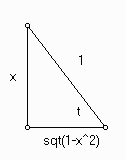Inverse Trig and Hyperbolic Derivatives
I. Return Midterm I
III. Definition of the Inverse Trig Functions
Recall that we write arcsinx to mean the inverse sin of x restricted to have values between -pi/2 and pi/2 (Note that sin x does not pass the horizontal line test, hence we need to restrict the domain.) We define the other five arctrig functions similarly.
III. Trig of Arctrig Functions:
Example: Find tan(acrsin(x))

The triangle above demonstrates that
sin(t) = x/1 = opp/hyp.
Hence adj = sqrt(1 - x2) Since the tangent is opp/adj. We have
| tan(arcsin(x)) = x/sqrt(1 - x2) |
Exercise
cos(arctan(2x))
IV) Derivatives of the Arctrig Functions
Recall that if f and g are inverses, then g'(x) = 1/f'(g(x))
What is d/dx(arctan(x))?
We use the formula:
1/sec2(arctan(x)) = cos2(arctan(x)).
Since tan(theta) = opp/adj = x/1, we have hyp = sqrt(1 + x2) so that
cos2(arctan(x)) = [1/sqrt(1 + x2)] 2= 1/(1 + x2)
Theorem:
|
d/dx(arctan(x)) = 1/(1 + x2) d/dx(arcsinx) = 1/sqrt(1 - x2) d/dx(arcsecx) = 1/xsqrt(x2 - 1)
|
Recall that cosx = sin(pi/2 - x) hence arccosx = pi/2 - arcsinx
hence d/dx(arccosx) = d/dx[pi/2 - arcsinx] = -d/dx[arcsinx] = -1/sqrt(1 - x2)
Similarly:
d/dx(arccot(x)) = -1/(1 + x2)
d/dx(arccscx) = -1/xsqrt(x2 - 1)
Example:
Find the derivative of cos(arcsinx)
Solution: let y = cosu, u = arcsinx
y' = -sinu = -sin(arcsinx) = x
u' = 1/sqrt(1 - x2)
We arrive at
d/dx cos(arcsinx) = x/sqrt(1 - x2)